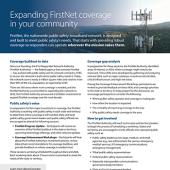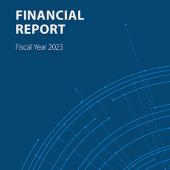This is the fourth entry in a blog series that will explore the FirstNet Authority Roadmap domains. You can also learn about: the Core, Coverage and Capacity, Situational Awareness, Secure Information Exchange, and User Experience. Download the full Roadmap at firstnet.gov/Roadmap.
Voice communications are the fundamental form of public safety communications.
At the heart of the FirstNet effort is the need for a reliable communications platform that will provide voice, data, and video services for public safety’s lifesaving mission. With the launch of FirstNet, countless first responders gained access to the most advanced broadband emergency communications solution available today, and the First Responder Network Authority (FirstNet Authority) strives to learn from public safety where the network needs to go next.
The FirstNet Authority Roadmap is designed to guide the growth, evolution, and advancement of the FirstNet network. Developed with input from public safety, industry, government, and our network contractor, AT&T, the Roadmap provides a view of public safety’s operational needs and technology trends for mobile broadband communications over the next five years.
The Roadmap is structured around six domains representing network capabilities that are vital to public safety operations. One of these domains is voice communications—the ability for public safety professionals to verbally communicate with one another across agencies, jurisdictions, and platforms. The FirstNet Authority envisions a nationwide network that provides high-quality, reliable voice communications and leverages all available voice-related technologies to ensure the most advanced feature set is available.
“FirstNet is our government's promise to create a highly reliable broadband communications network for public safety to support voice, data, and video,” said Kevin Nida, FirstNet Authority Senior Public Safety Advisor, 37-year veteran of the fire service, and former fire battalion chief for the Los Angeles City Fire Department in California. “Having worked through more than three decades of major emergencies, including major earthquakes, civil disturbance, scores of brush fires and Hurricane Katrina, I know that reliable voice communications is the ‘bread and butter’ of the fire service. The ability for the FirstNet network to seamlessly integrate land mobile radio and broadband voice communications—that is compliant to open 3GPP mission critical standards—will expand public safety communications, while leveraging off-network communications as well. FirstNet users will not have to give up anything, but will be able to leverage the best of both technologies for greater range, interoperability and capacity,” said Nida.
Listening to public safety: Identifying the voice communications domain and learning what responders need next
To keep their communities safe, it is essential for responders to get dispatched via voice for priority calls, and when tactically working with one another, voice is preferred for coordinating operations in real time. The voice communications Roadmap domain was developed with significant input from the public safety community.
To develop the Roadmap, the FirstNet Authority discussed voice communications with nearly 7,600 public safety representatives from 46 states between April and June of 2019. From those meetings, three Roadmap priorities were identified for voice communications. These priorities continue to be developed into a series of initiatives that will drive the FirstNet Authority’s programs, activities, and investments. The current priorities are:
- Work with public safety to assist in operationalizing FirstNet’s 3GPP mission critical complaint push-to-talk solution by educating on relevant use cases and supporting efforts to establish relevant nationwide governance and policies.
- Continue an active role in 3GPP and other relevant LMR-LTE standards development focused on mission critical push-to-talk (MCPTT) and dispatch advancements.
- Advocate for continued implementation of important MCPTT features such as device-to-device communications (ProSe), LMR-LTE interconnection, and dispatch capabilities.
Over the top push-to-talk (PTT) apps were available for use on FirstNet early on, allowing us to put them in action. Agencies supporting the Volvo Ocean Race in Newport, Rhode Island, used a PTT app to speed coordination and response. During the event, which drew over 100,000 tourists over 13 days, incident commanders used a PTT app to contact on-site emergency medical professionals and dispatch the closest emergency medical services team to respond to an emergency.
Voice communications over FirstNet recently underwent a solid test by public safety in the field during the Kansas City Chiefs championship parade after the Super Bowl. During the parade, 80 FirstNet devices were given to public safety officials, who tested voice calls, sent and received video, and verified push-to-talk functionality.
The FirstNet Authority monitors operational demonstrations like these to identify needed features and possible improvements. We also continue to engage with public safety during hundreds of individual engagements, workshops, and summits. From October 2019 to February 2020, the PSA team conducted 534 engagements and of those, nearly 49 percent (262 engagements) addressed voice communications in some form.
Push-to-Talk augments existing systems
One of our primary goals within the voice communications domain is to support public safety’s use of a robust FirstNet Push to Talk solution, built to 3GPP mission critical standards, over the nationwide public safety broadband network. This goal includes providing public safety with an additional communications tool that augments their existing land mobile radio (LMR) system. The FirstNet Authority is working within the 3GPP standards body to drive innovations for mission critical push to talk, including standards that provide the ability to interoperate with the thousands of LMR networks currently in use so that first responders can both leverage new broadband capabilities, while interoperating with existing LMR systems.
Our goal is to drive forward the ability to operationalize and efficiently implement this service, guide standards to expand and grow the capabilities, and solicit feedback from public safety so that we can advocate for features they need and identify any existing service gaps. The FirstNet Lab and Experience Program offer the chance for responders to interact with devices and apps in order to give feedback.
In March 2020, AT&T announced FirstNet Push-to-Talk (PTT), the first-ever nationwide mission-critical standards-based push-to-talk solution to launch in the U.S. A standards-based approach is what public safety called for and will help drive costs down and features up for public safety. FirstNet PTT is currently available in a controlled-introduction. This is an initial release and the solution will continue to evolve and mature, like any other product in the FirstNet ecosystem. FirstNet Authority staff are keeping in close contact with early adopters to learn from their experiences—public safety will decide when push-to-talk is proven enough to meet their needs.
Using push-to-talk built to MCPTT standards can help expand agencies’ operational footprint using cellular coverage via LMR interoperability when users our outside of the agencies LMR footprint. Already there has been rapid progress in the commercial push-to-talk market to create talk groups that interoperate with LMR.
The Indiana Integrated Public Safety Commission is in the initial phase of integrating its LMR with FirstNet for enhanced communications. This LMR to LTE connection establishes a backup to their system and saves the state money. An app installed on their FirstNet-enabled phones allows them to talk over radios, grant situational awareness to administrative staff who don’t have high-dollar radios, and let users operate off of Wi-Fi and cell towers. Along the way, they have discovered additional benefits. For example, school resource officers are able to use a FirstNet-enabled smartphone with Wi-Fi to connect with the statewide radio system talk groups while in school buildings, where it is normally difficult to get a radio signal.
Mission critical services, especially voice, are key components for a differentiated public safety network experience. Understanding the critical communications needs of public safety entities, will help refine solutions until they are tuned to responder needs. We are looking towards the future so that responders and industry can best leverage the broadband capabilities that FirstNet provides.
For public safety, by public safety
The FirstNet Authority Roadmap belongs to public safety. It was guided by feedback from responders across the country and will evolve with their continued input. If you have input on targeted outcomes for the Roadmap or public safety innovations to help you and your agency’s operations, reach out to your Public Safety Advisor to schedule a meeting or learn how to engage with the FirstNet Authority.
For more information on the Voice Communications domain, including key technology areas, and its relation to the other five Roadmap domains, visit www.firstnet.gov/roadmap.




















